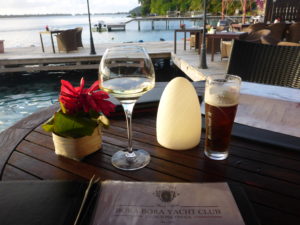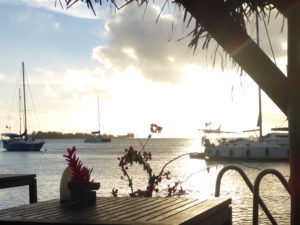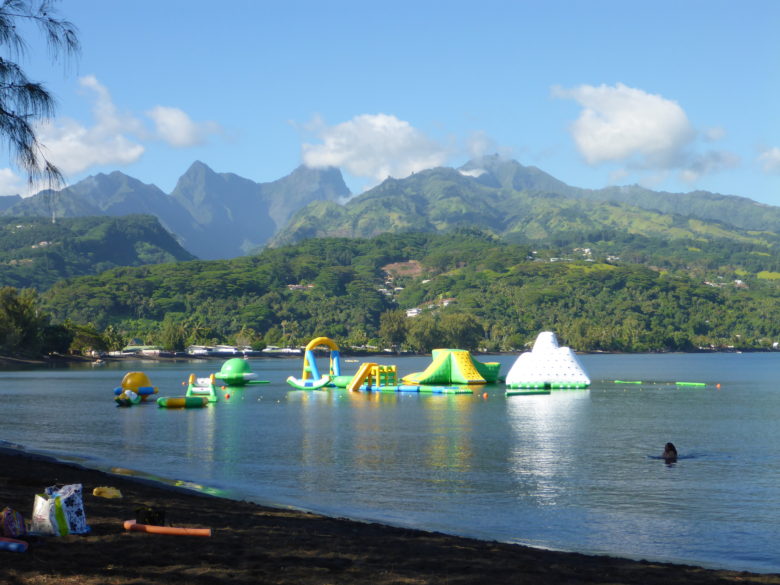17:35.18S 149:36.93W Tahiti and following on in Cook’s Wake.
We started by taking our life in our hands walking toward the oncoming traffic on a busy dual carriageway, (haven’t seen one of those since Bahia) for 10 minutes, to the Carrefour supermarket. Enterprising farmers set up their stalls along the road side to sell fruit and veg and vehicles pull off the road and completely block the pavements, so we have to walk in the road.
Our defence was the shopping trolley we found in the marina car park and pushed before us, filled to the brim on the return journey.
Then we had lunch in the Pink Coconut Restaurant, one of the two on the marina site. Neither have WIFI, which we soon learned is still being metered out expensively and inconveniently on the island. The only reasonable WIFI we found was at our bar in town, The 3 Brasseurs, where it is free for an hour at a time and they brew their own beer, the bright copper tanks almost on the pavement and there for all to see. The beer, and we favoured the Ambre, is excellent, “The best since Lima” I told the waitress, and strong around 6%. They also sold it in the other bar at the marina, just a few metres from Zoonie, how handy is that.
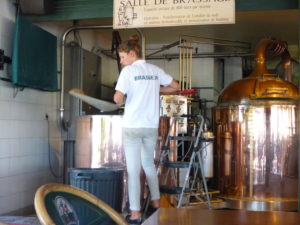
Our second day here got two hot washes done in their efficient top loaders and two electricians, Tony and Will, came aboard and confirmed our suspicions that the battery charger does not work at all. So no boosting the batteries to 100% on the mains, and frequent running of the engine in the marina to do the job instead.
A friendly taxi driver from Vanuatu sped us into the Capital, Papeete and dropped us outside the Tourist Info hut near where the Aranui 5 has her mooring. I spent the entire morning in a cyber cafe, posting pictures to Yachting Monthly (again) and to the blog, while Rob explored and found ‘our’ bar for our first of two visits.
We wandered along the modern promenade and back along the street wondering what the friendly Papeetians had done to deserve the 1960/70’s concrete architecture that reflected the excesses of European modernism and none of the local culture.
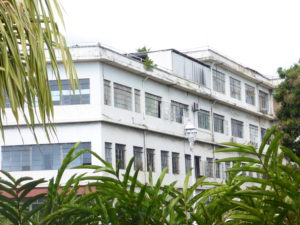
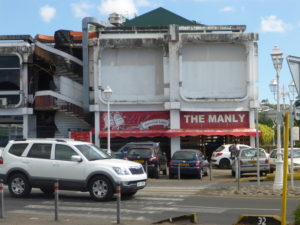
Many years ago King Pomare V died leaving no heirs so the monarchy died out. He did marry early on and I gather his wife had three children, but they divorced and she went to live in a modest wooden bungalow in the city centre and spent the rest of her life studying and translating historical works. The bungalow is still there, surrounded by a high rise Hotel, and her descendants still live in it. I took a photo which shows its dilapidated condition and wonder if it will be restored and opened to the public at some later date.
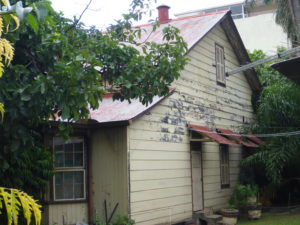
Big cruise liners moor in the harbour so the touristy, glitzy element in the market and shops was understandable. We had arranged a hire car and couldn’t wait to explore the two islands away from the capital.
An elderly lady sat at the wheel of our bus back to the marina and progress was sedate, around 30mph, with all windows open and few seats available. The buses are regular and cheap. £16 by taxi, £3.50 by bus.
Riding on the success of our first bus ride we waited outside the marina the next day for one to take us away from Papeete to the Museum of Tahiti a few kilometres up the road. I had sat in the cockpit and watched what time they stopped outside the marina, 7 minutes past the hour. We walked a mile from the stop through an urban area of walled homes, all very modest in size with pretty gardens and witnessed the transition from public transport and bikes, still prevalent for the poor and visiting yachties, to car ownership which is starting to choke the island as in so many other parts of the world.
I nearly tripped over the bottom three inches of what was once a bus stop sign alongside a disused shelter. The buses now stay on the main roads as everyone on the estates have cars.
The museum was excellent, built on the site of Hiti, residence of the former chiefs of Puna’auia, with a lovely ornamental, sacred and medicinal garden of low plants, overlooking the sea and a good collection of dugouts, boats sewn together, Rob didn’t have too much confidence with these, and piroques.
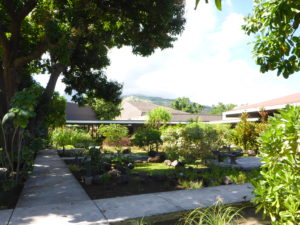
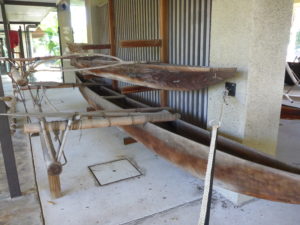
We arrived back at the dual carriageway to see ‘our’ bus pull up just as we prepared to cross. Missed it by a whisker and had an hour wait in the sun, fortunately we were wearing hats and I had my brolly.
The first beer in 3 Brasseur did not touch the sides.
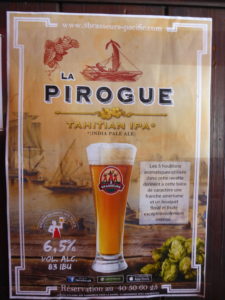
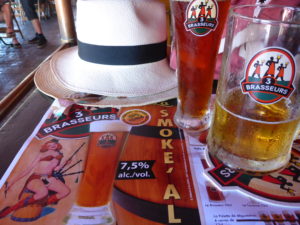
The next day, Sunday 14th, was my birthday. I washed Zoonie’s stainless steel while Rob made a bracket to keep the stowed wash boards in place, using a nice bit of scrap teak he found on the wood tip, both jobs completed before the sun became too strong. After showers, smoked salmon scrambled eggs in the cockpit went down well.
Actually it was quite cloudy, ideal for our planned and prepared for canoe ride from Zoonie, out of the marina and over to the reef. Many boats were anchored in the white sand beneath the crystal clear water. People stood around, waist deep in cool water chatting and drinking, some set up BBQs in the water and were cooking, ladies were laying tables for lunch and children played, splashed and snorkelled to their hearts content.

I took some photos, holding the camera under the water. We went and explored the passe we planned to use to exit the lagoon. The reef drops from a meter or so into deep blue so we think we will be fine. On arrival we entered through the main Papeete Passe and had to radio Port Control to get clearance to enter the passe, then to pass the top end of the airport runway and again to pass the far end of the runway, that or have a twin engine Otter in our rig or be caught up under an Airbus A300 bound for New Zealand!
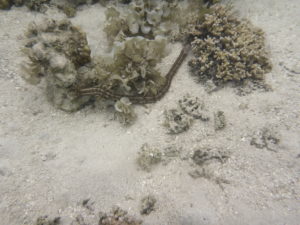
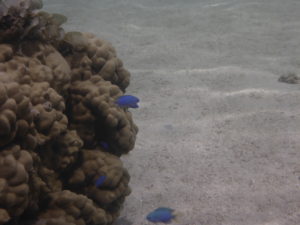
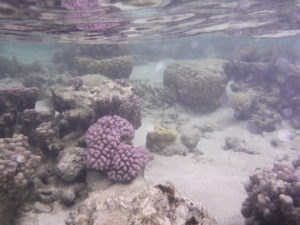
Just before we started paddling across the channel back into the marina a turtle floated by popping his head vertically above the water twice for a breath and look see.

Back in the cockpit, a glass of demi-sec in hand we drank toasts to everyone we could think of before Rob disappeared off to Carrefour. He returned with a lovely pear and chocolate birthday cake, and Tahitian Tea and Coffee and chocolate and a carved conch shell by way of lovely presents.
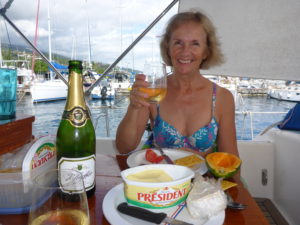
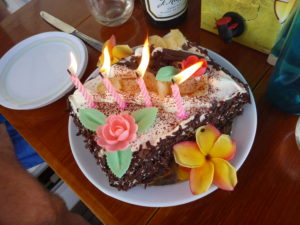
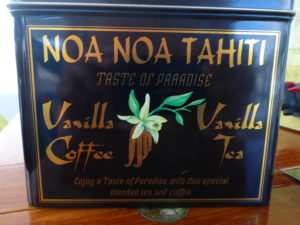
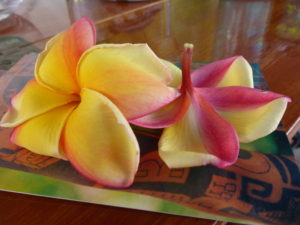
Banned from taking the car on any of the tracks to the mountain tops and various other sites we ventured along the coast road and found a number of caves formed by the rainwater pouring over the sheer rock face for millions of years. Lakes had formed in the hollows dissolved out of the rock face and someone had laid out a garden and pathways for the traveller to relax in.
In another similar place the sacred theme of the nine stages chiefs went through after death on their journey to nirvana was incorporated into the garden. Equally charming and equally free!
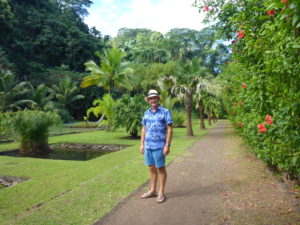

To our left the mountain passes rose to the towering peaks with a vast variety of tree shapes adorning the valleys like jewels in a cleavage. Tahiti is made up of two joined islands each with its own singular extinct volcano. We crossed over to little Tahiti on our way to Teahupo’o from where the most dangerous wave in the world (so they say) of the same name, each year claims at least one healthy male surfer.
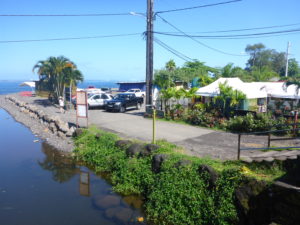

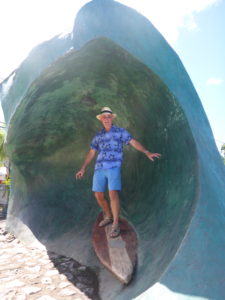
Compared with Jaws and Belharra this wave is not the biggest, it is its thickness, power, the sharp coral reef below and its speed which give it a fearful reputation and magnificent challenge. It is large enough to garage two trucks however and when it forms its speed is so rapid the contestants have to be towed into place with a jet ski.
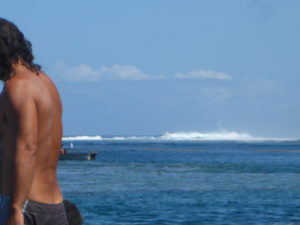
The International trials had been held just before we arrived and the contest would start in earnest a few days later when the wave was expected to form. The excitement was building. A small stage had been built and the judging hut that is built out on the reef near to the waves expected location was adorned with advertising for the sponsors, Vodafone, Billabong and Go Pro amongst them.
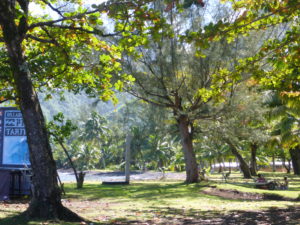

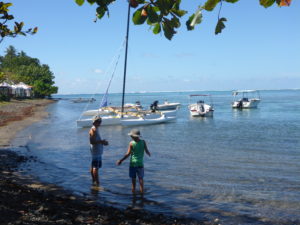
The contestants are accommodated with families in their homes all around the coast (there are no big hotels). They are judged on the style, length of ride, whether they actually enter the wave, how long they stay in the tube and the quality of their finish. A worrying time for some mums!
Tahitians, on their days off, like to picnic and this holiday Monday was no exception. Big groups from the local area got together at venues all over the island and set up gazebos and long folding tables and everyone would bring something. They looked like really happy occasions. We sat and had our lunch a discreet distance away.
Imagine if you can dear reader, the life of a Tahitian dairy farmer. As usual the upper regions of the slopes are ideal for lush fields and happy cows munching on thick, constantly growing grass. This particular farmer was strimming the lawn infront of his modest single storey home, itself cool under the deep shade of the overhanging eaves.
At any time he could look up and see before him his lush pastures spotted with red, black and white, pure white and silver grey cows and calves and beyond that the entire width of big Tahiti from east to west coast. The sun glistening on the sea and the thin curvy lines of the white water breaking over the edge of the reefs from the deep, dark blue into the most beautiful turquoise lagoons over pure white coral sand on both sides of the mother island.

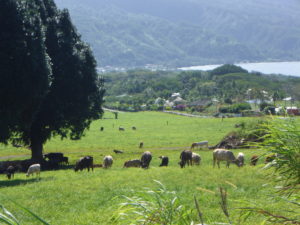
He would have to contend with the rainy season though, and with the red soil, just like in Devon, there would be muddy times and muddy cows but always enough warmth so they could stay outside the year round. Not a bad lot I thought.
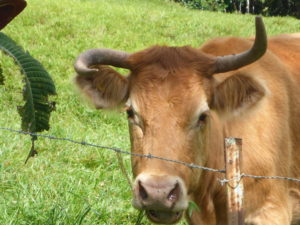
On our way ‘home’ we came to a beach recommended by the lady in the tourist office. The car park being full we found a slot on the roadside. Licking pistachio ice cream we took in the surroundings, a long beach with many folk enjoying the safe lagoon, sitting or swimming in the warm waters. We decided on tomorrow for our beach time when the crowds would be gone to work and school.

In the cool of the early morning we found the lighthouse at Point Venus built by Robert Louis Stevenson’s family and by it the Cook monument that recalls the period of weeks Captain Cook spent here in 1769 recording the transit of Venus. This episode brought Tahiti to the notice of the Western world.
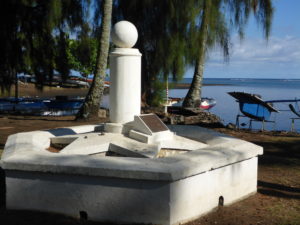
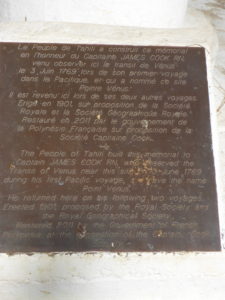
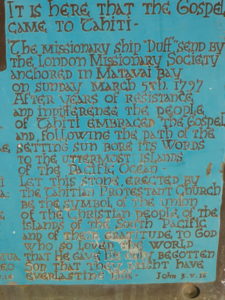
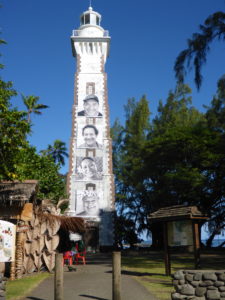
Another interesting fact about these islands is that they are the only Amphidromic point on the face of the earth; that is where only the sun causes the tides and tidal range, not the moon as well.
A more earthly spectacle took our interest next. The blow hole or more elegantly the trou du souffleur, makes a fabulous booming sound before it shoots the sea water back through the natural hole in the rocks to the ocean.
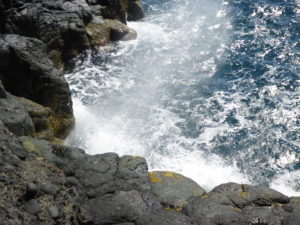
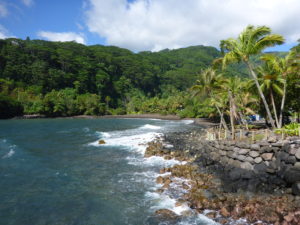
Vaina Beach was sparsely scattered with sun bathers as we sat having our light lunch before a snorkel over the reef. It was really nice to just relax for a few hours. A young man, clad in black from cap to shorts sat next to his long canoe with its outrigger. He was a bit overdressed compared to the rest of us. He stayed a while as if resting and then re-launched his boat and paddled hard and fast back out towards the fringe of the reef. He was worth watching.
In the last few hours of our car ownership we did a fresh produce shop at Carrefour, this time without the need to run the gauntlet with the dual carriageway traffic, had a final sundowners of Ambre Beer and then supper of the tasty fish, Mahi Mahi back on board.
Our agent Tehani, confirmed there was plenty of room for us to pass through the channel we had explored in the canoe, so off we set with our clearance to Bora Bora done, and our next destination, Moorea upon whose dramatic skyline we had looked a hundred times in the past week.
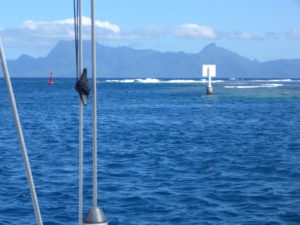
Today we will leave for Moorea on the recommendation of an Irish family who also have an Oyster and who we first met in Nuku Hiva. Moorea sits like an Ascot Hat on Ladies Day above Tahiti and one of the fixings for the overlong feathers hanging from the top of the hat is the little bay we are heading for, Cook Bay, named after the visit of the magnificent English navigator, Captain James Cook, 250 years ago.
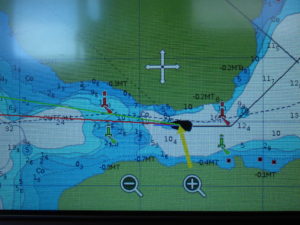
The wind was brisk, 25+ knots funnelling between the two islands and Zoonie did well with just a reefed genoa. The engine was running, out of gear, to put a charge into the batteries, on our way to Cook’s Bay, where he had anchored in 1769.
We motored deep into the bay, another flooded caldera with high volcanic rock faces and peaks all around us. It was a spectacular scene. Natural except for the small fields and habitations that spread along the road on the shore. I might say peaceful except that at least eight dogs kept up a barking match well into the evening. The fresh breeze that fell towards us from the mountain slopes on our entry soon faded and Zoonie rested very peacefully on her anchor embedded in volcanic mud in 13 metres of water.

16:38.40S 151:29.09W Tahaa above Raiatea. A fine cruise but some sad news.
We had 103 miles to go and set off the next morning with the diva flying in fine style and overnight a ship and a sailing vessel passed us along our reciprocal course. Then in the darkness a weird combination of lights approached. All golden and in a near vertical line as if on a back stay, from masthead to stern.
As it approached we could see a green nav light low down and the very faint glow of four equal height masts. AIS described her as the Wind Spirit, 134 metre motor sailing yacht who takes up to 290 paying passengers from Tahiti around the islands. Nice work if you can get it! As I write she has just come in here, to Bora Bora so maybe we’ll sneak aboard for a look later. She reminds me of the Royal Star Clippers that ply the Caribbean whom I have seen before. I even had the son of one of the officers as a driving pupil before he went off to Dartmouth Naval College. Lovely lad he was.
At some stage the next day we opened up our emails, while underway and found one from Tracey about Toby, our springer spaniel now in the care of Tracey and Darren. The previous Sunday she told us that he was having tests for an enlarged prostate and spleen so we had been awaiting a progress report. It was Thursday the 18th. Toby suddenly lost the use of his back legs and as the vet felt there was nothing more they could do for him, as he had some problem in the mid back region, he put Toby to sleep. He was 11 years 3 months old.
We felt for Tracey and Darren as only a few weeks before they had had to put another of their dogs, Missee, to sleep as she was fitting.
On arrival at Raiatea we entered the lagoon through the Teavapiti Passe with the intention of anchoring or picking up a buoy off the main town of Ururoa but as the anchorage was around 30 metres deep and the only buoys we found belonged to charter companies, we motored on toward Tahaa, the island to the north.
There was a marina on Raiatea but we hadn’t prepared ourselves and it looked very full anyway. Haamene Bay seemed a good prospect and we went right in to the far end and anchored on mud once more. The Hibiscus Hotel was to our right with colourful write-ups of accommodation, good food, trip arrangements and free buoys off etc but as we went past there was not a sign of life.
This cleft in the volcano is one of the favoured hurricane holes in the area and is geographically practically mid island. I could imagine it will become crowded soon, as the season approaches, November to April, when we will be in New Zealand.
But as it was for us a very peaceful spot we sat in the cockpit looking at photos of dear Toby on Rob’s phone, as the sun went down on his last day.
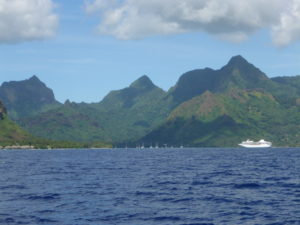
Next morning we motored around the island, inside the lagoon noting the different shades of blue of the water not just for beauty but because the darker blue was the deeper water. Keeping eyes open for the red and green posts and the IALA posts with their top marks showing from which side of the danger they were positioned. At Pai Pai Passe we hung a left and headed for the open sea. Bora Bora was visible 20 or so miles away and for the first time in ages we put the main out and sailed in a brisk wind with both white sails pulling nicely.
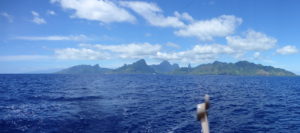
We are using lovely blue, grey and white charts for this area and although they are up to date or at least recent, some were first prepared back in the nineteenth century, with palm trees drawn on the islands. You know, the sort you sometimes see framed on pub walls or a tabletop decorations under protective glass. Rob says “These you won’t be selling on Ebay my love!”
On approach to Bora Bora our course was well out from the island as the lagoon is vast and the reef wide, with its own islands. Past the Pointe de Turi Roa Pillar, 43 feet high, white with a black top and we were in line for the entrance. With a cat infront of us that handily confirmed the entrance through Passe Te Ava Nui we finally picked up a buoy off the Bora Bora Yacht Club.

It is not really a yacht club instead a restaurant and bar with half a dozen thatched huts on site, very pretty grounds rather like Puerto Amistad and a safe enclosed tiny pool area like a play area for children with benches and tables for adults all rooted in the water!
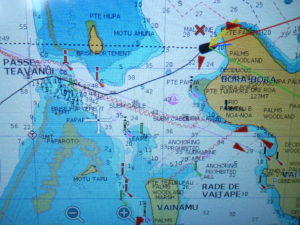
We had a welcome Ambre beer and returned at five for a meal. “Most people eat at around five so they can watch the sunset between Motu (Coral mount) Ahuna and Teveiroa.” The waiter said, so that’s what we did.
